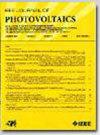粗糙几何集光面能量的概率质量函数及其在城市能源和光伏中的应用
IF 2.6
3区 工程技术
Q3 ENERGY & FUELS
引用次数: 0
摘要
整个城市地区的阳光在很大程度上影响着当地气候[可持续发展目标(SDG) 13]、居民福祉(SDG 3)和清洁能源的获取(SDG 7)。然而,不同城市表面的阳光可用性受到城市几何形状的影响。在这里,在这项工作中,提出了一个概率框架来评估阳光和城市几何之间的相互作用,并展示了其在城市能源研究中的直接应用。推导了一个概率质量函数,该函数预测了一组光收集表面的能量产生,例如安装在粗糙几何形状的太阳能光伏(PV)系统,例如城市地区。在此过程中,天空视野因子(SVF)的表达式在粗略的几何形状中形成,以及住宅光伏车队的容量因子与城市几何形状之间的联系。使用数字表面模型和收集的荷兰光伏系统数据验证了数学框架的预测。这项工作主要有助于理解粗糙表面的几何参数与该表面子集上接收的阳光能量之间的潜在关系。应用实例包括快速SVF计算和住宅光伏发电机组产量预测,它们分别支持高效的城市能源评估和保护隐私的电网管理。本文章由计算机程序翻译,如有差异,请以英文原文为准。
Probability Mass Function of Energy for Light-Collecting Surfaces in Rough Geometries and Its Applications in Urban Energy and Photovoltaics
Sunlight throughout urban areas largely impacts local climate [sustainable development goal (SDG) 13], residents’ well-being (SDG 3), and access to clean energy (SDG 7). However, sunlight availability on various urban surfaces is affected by urban geometry. Here, in this work, a probabilistic framework to evaluate the interplay between sunlight and urban geometry is presented, and its immediate applications in urban energy studies are demonstrated. A probability mass function that predicts the energy production of a group of light-collecting surfaces, such as solar photovoltaic (PV) systems, installed in rough geometries, such as urban areas, is derived. Along the way, an expression for the sky view factor (SVF) is formulated within rough geometries as well as a link between the capacity factor of the residential PV fleet and urban geometry. The predictions of the mathematical framework are validated using the digital surface model and collected PV systems data in The Netherlands. This work primarily helps understand the underlying relation between the geometrical parameters of a rough surface and the received sunlight energy on a subset of that surface. Exemplified applications are swift SVF calculations and residential PV fleet yield predictions, which, respectively, support efficient urban energy assessments and privacy-preserving electrical grid management.
求助全文
通过发布文献求助,成功后即可免费获取论文全文。
去求助
来源期刊

IEEE Journal of Photovoltaics
ENERGY & FUELS-MATERIALS SCIENCE, MULTIDISCIPLINARY
CiteScore
7.00
自引率
10.00%
发文量
206
期刊介绍:
The IEEE Journal of Photovoltaics is a peer-reviewed, archival publication reporting original and significant research results that advance the field of photovoltaics (PV). The PV field is diverse in its science base ranging from semiconductor and PV device physics to optics and the materials sciences. The journal publishes articles that connect this science base to PV science and technology. The intent is to publish original research results that are of primary interest to the photovoltaic specialist. The scope of the IEEE J. Photovoltaics incorporates: fundamentals and new concepts of PV conversion, including those based on nanostructured materials, low-dimensional physics, multiple charge generation, up/down converters, thermophotovoltaics, hot-carrier effects, plasmonics, metamorphic materials, luminescent concentrators, and rectennas; Si-based PV, including new cell designs, crystalline and non-crystalline Si, passivation, characterization and Si crystal growth; polycrystalline, amorphous and crystalline thin-film solar cell materials, including PV structures and solar cells based on II-VI, chalcopyrite, Si and other thin film absorbers; III-V PV materials, heterostructures, multijunction devices and concentrator PV; optics for light trapping, reflection control and concentration; organic PV including polymer, hybrid and dye sensitized solar cells; space PV including cell materials and PV devices, defects and reliability, environmental effects and protective materials; PV modeling and characterization methods; and other aspects of PV, including modules, power conditioning, inverters, balance-of-systems components, monitoring, analyses and simulations, and supporting PV module standards and measurements. Tutorial and review papers on these subjects are also published and occasionally special issues are published to treat particular areas in more depth and breadth.
 求助内容:
求助内容: 应助结果提醒方式:
应助结果提醒方式:


